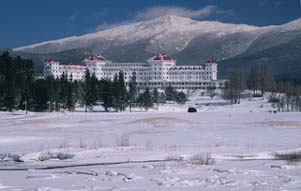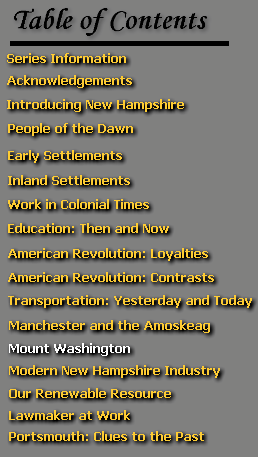SUMMARY
 "Mount
Washington...head in the clouds...roots firmly planted in the heart of
New Hampshire." This lesson explores the various meanings of the rugged
mountain. Formed by great glaciers 50,000 years ago, Mt. Washington is
the highest peak in the Northeast. With its summit in the path of a storm
belt, its combination of high winds, low temperatures and ice-forming fog,
it has the most severe weather of almost any place in the world. Its unique
weather patterns create an arctic-like environment for plants, animals
and people. "Mount
Washington...head in the clouds...roots firmly planted in the heart of
New Hampshire." This lesson explores the various meanings of the rugged
mountain. Formed by great glaciers 50,000 years ago, Mt. Washington is
the highest peak in the Northeast. With its summit in the path of a storm
belt, its combination of high winds, low temperatures and ice-forming fog,
it has the most severe weather of almost any place in the world. Its unique
weather patterns create an arctic-like environment for plants, animals
and people.
Dominating all the other
peaks around it, Mt. Washington has a spirit all its own, one that has
always demanded respect. The early white settlers sought ways to avoid
the mountain.
Beginning with Timothy Nash's
accidental discovery of a pass through the mountains in 1771, life around
Mt. Washington began to flourish. There came Ethan Allen Crawford, the
first innkeeper of the White Mountains; the Willey family, who lost their
lives in a landslide; Daniel Pinkham, who discovered Pinkham's Notch; and
the Copps, who opened their farm to weary travelers.
When the railroad came to
Pinkham's Notch in 1851, Mt. Washington soon became a very popular place
for vacationers. Tourism generated hotel business as well as construction
of a carriage road and a cog railroad to the summit. Primitive attempts
to provide some kind of accommodations on the summit culminated in the
erection of two Summit Houses. The latter, completed in 1873, held 50 guests,
served formal dinners, published a newspaper, and featured its own symphony
orchestra.
For nearly two centuries,
hundreds of thousands of people have made their way to the top of Mt. Washington,
seeking adventure, peace and tranquillity, a challenge, and a panoramic
view which includes parts of five states and Canada.
The observatory on Mt. Washington
dates back to the 1850s. Now manned year-round, the station crew works
for various research projects, and daily weather reports are still made
to radio and TV stations in the Valley. At the TV transmitter station,
which has joined the observatory at the Summit, engineers spend week-long
shifts doing live weather shows and monitoring TV signals for WMTW-TV in
Poland Springs. Maine.
In the last two hundred years,
New Hampshire's Mt. Washington has played host to a variety of people and
served the state in a myriad of ways. Its harsh weather patterns and tremendous
views have changed very little. Still, its unique ecology can be threatened
by man's carelessness and irresponsible actions. It is a majestic mountain
which invites us to enjoy its vistas and beauty, but which will remain
unscarred only if we are responsible for it and use it carefully.
OBJECTIVES
1. To explore the
history of Mt. Washington, its formation, terrain, and the activities it
has housed.
2. To catch a glimpse
of its ecological environment, hence gaining respect for its uniqueness,
harshness and beauty.
3. To investigate
the persons involved in the history of Mt. Washington.
4. To consider the
value of the mountain to our state and others, and to develop an awareness
of our part in its preservation.
PRE-VIEWING ACTIVITIES
1. Locate Mt. Washington
and the surrounding White Mountains on a map; note their names and elevations.
2. Discuss what you,
as class members, already know about Mt. Washington. Be sure to include
personal experiences.
3. Think about what
an alpine environment is like during the different seasons as compared
to where you live. Consider what effect those climates might have on the
types of plants and animals living there.
4. Review how glacial
activity takes place, relating it to the formation of the Presidential
Range.
5. Consider how Mt.
Washington might be important to our state's economy, wildlife, and lifestyles.
POST-VIEWING ACTIVITIES
1. Discuss the following
questions:
What kind of vegetation
grows on Mt. Washington?
How does Mt. Washington
compare in age to the Rockies?
Why was Ethan Allen Crawford
called "the first innkeeper of the White Mountains? What other feats are
attributed to him?
What was the eastern valley
pass called? The western valley pass?
What distant areas can be
seen from the top of Mt. Washington?
What kind of activities
now take place on Mt. Washington?
What kinds of activities,
human or otherwise, could destroy the beauty and terrain of Mt. Washington
as we know it today?
2. Develop a graphic
presentation showing such things as weather patterns on Mt. Washington,
glacial action causing the mountain's formation.
3. Identify some of
the alpine flowers on the mountain.
4. Consider the alpine
climate's effect on vegetation and animal life.
5. Write an essay
on a topic such as the mountain's history, the observatory.
6. Plan a one-day
hike up the mountain, considering absolute necessities for the venture.
Actually execute the hike or one to a closer peak, preferably one which
affords a firetower view of Mt. Washington.
7. Discuss in detail
some of the effects of not being prepared for the outdoors.
8. Begin a rock collection
of New Hampshire's geological makeup.
9. Invite a speaker
to class who has climbed and/or spent time on Mt. Washington.
10. Begin a collection
of Indian legends, folklore revolving around the mountains.
11. Investigate the
workings of: a wind gauge, barometer, rain gauge.
12. Report on: Ethan
Allen Crawford, Daniel Pinkham, or others.
13. Read about the
observatory cats of Mt. Washington.
14. Brainstorm and
list the duties of a transmitter crew and weather crew.
15. Develop a photographic
essay on the White Mountains.
16. Develop a skit
about one day in a mountain observatory or about an Indian powwow discussing
the mountain's spirit.
17. Study some of
the adaptations the animals (including man) must make in order to stay
alive in the mountain's harsh environment.
18. Create some poems
which capture the thoughts of a mountain crew member, Indian, early settler,
student today (i.e., isolation, peace, beauty).
19. Begin a postcard
collection of the White Mountains.
20. Develop a set
of your own rules which people would observe while vacationing in the White
Mountains. Compare your rules with those already in existence.
21.
Begin a unit on wilderness survival, considering things like shelter building
and edible plants.
Top
VOCABULARY
-
rime ice
-
trestle
-
trailblazer
-
arctic zone
-
transmitter
-
notch
-
temperate zone
-
generator
-
landslide
-
wind gauge
-
frostbite
-
barometer
-
cog railroad
-
meteorology
-
glacier
PLACES TO VISIT
-
Glen Ellis Falls
-
White Mountain National Forest
-
Cog Railway
-
Pinkham Notch AMC Hut
-
Wildcat Gondola
-
Willey House (Crawford Notch)
-
Heritage House
-
Cannon Mountain
-
Aerial Tramway
-
Mt. Cranmore
-
Glen Boulder
PEOPLE TO KNOW
-
Ethan Allen Crawford
-
Daniel Pinkham
-
Sam and Polly Willey
-
Governor Wentworth
-
Timothy Nash
-
Hayes and Dolly Cobb
WEB RESOURCES
|




